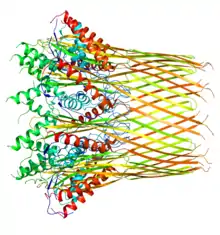Curli
The Curli protein is a type of amyloid fiber produced by certain strains of enterobacteria. They are extracellular fibers located on bacteria such as E.coli and Salmonella.[2] These fibers serve to promote cell community behavior through biofilm formation in the extracellular matrix. Amyloid is associated with human neurodegenerative diseases such as Alzheimer's disease.[3] The study of curli may help to understand human diseases thought to arise from improper amyloid fiber formation.[2] The curli pili are generally assembled through the extracellular nucleation/precipitation pathway.[4]
| Curli secretion channel | |||||||
|---|---|---|---|---|---|---|---|
 | |||||||
| Identifiers | |||||||
| Organism | |||||||
| Symbol | CsgG | ||||||
| Entrez | 945619 | ||||||
| PDB | 3X2R | ||||||
| RefSeq (mRNA) | NC_000913.3 | ||||||
| RefSeq (Prot) | NP_415555.1 | ||||||
| UniProt | P0AEA2 | ||||||
| Other data | |||||||
| Chromosome | Genomic: 1.1 - 1.1 Mb | ||||||
| |||||||
.pdf.jpg.webp)
Gene regulation
CsgD is a positive transcriptional regulator of the csgBA operon. The CsgD protein is the transcription regulator and positively regulates the csgBA operon but shockingly does not regulate its own expression. The csgBA operon encodes the major structural subunit of curli, CsgA, as well as the nucleator protein CsgB. Further research still needs to be conducted in order to see what stimulates CsgD expression or activity but some evidence supports that the activation of the protein is caused by the phosphorylation of an aspartic acid residue of the N-terminal receiver domain. Since CsgD must be present for csgBA promoter activity, it is therefore shown that regulators of CsgD expression also influence the expression of csgBA.[2]
Many environmental cues play a role in Curli gene expression. Growth at a temperature below 30 degrees celsius promotes Curli gene expression.[2] Additionally, when there is a lack of salt and nutrients such as nitrogen, phosphate and iron, Curli gene expression is stimulated.[2]
References
- Praveschotinunt P, Duraj-Thatte AM, Gelfat I, Bahl F, Chou DB, Joshi NS (December 2019). "Engineered E. coli Nissle 1917 for the delivery of matrix-tethered therapeutic domains to the gut". Nature Communications. 10 (1): 5580. doi:10.1038/s41467-019-13336-6. PMC 6898321. PMID 31811125.
- Barnhart MM, Chapman MR (2006). "Curli biogenesis and function". Annual Review of Microbiology. 60: 131–47. doi:10.1146/annurev.micro.60.080805.142106. PMC 2838481. PMID 16704339.
- Chapman MR, Robinson LS, Pinkner JS, Roth R, Heuser J, Hammar M, Normark S, Hultgren SJ (February 2002). "Role of Escherichia coli curli operons in directing amyloid fiber formation". Science. New York, N.Y. 295 (5556): 851–5. Bibcode:2002Sci...295..851C. doi:10.1126/science.1067484. PMC 2838482. PMID 11823641.
- Hammar M, Bian Z, Normark S (June 1996). "Nucleator-dependent intercellular assembly of adhesive curli organelles in Escherichia coli". Proceedings of the National Academy of Sciences of the United States of America. 93 (13): 6562–6. doi:10.1073/pnas.93.13.6562. PMID 8692856.
Further reading
- Dema B, Charles N (January 2016). "Autoantibodies in SLE: Specificities, Isotypes and Receptors". Antibodies. Basel, Switzerland. 5 (1): 2. doi:10.3390/antib5010002. PMC 6698872. PMID 31557984.
- Gallo PM, Rapsinski GJ, Wilson RP, Oppong GO, Sriram U, Goulian M, Buttaro B, Caricchio R, Gallucci S, Tükel Ç (June 2015). "Amyloid-DNA Composites of Bacterial Biofilms Stimulate Autoimmunity". Immunity. 42 (6): 1171–84. doi:10.1016/j.immuni.2015.06.002. PMC 4500125. PMID 26084027.
- Kono DH, Baccala R, Theofilopoulos AN (December 2013). "TLRs and interferons: a central paradigm in autoimmunity". Current Opinion in Immunology. 25 (6): 720–7. doi:10.1016/j.coi.2013.10.006. PMC 4309276. PMID 24246388.
- Tursi SA, Lee EY, Medeiros NJ, Lee MH, Nicastro LK, Buttaro B, Gallucci S, Wilson RP, Wong GC, Tükel Ç (April 2017). "Bacterial amyloid curli acts as a carrier for DNA to elicit an autoimmune response via TLR2 and TLR9". PLOS Pathogens. 13 (4): e1006315. doi:10.1371/journal.ppat.1006315. PMC 5406031. PMID 28410407.